Beko CH 142120 DX User Manual [ru]

Refrigerator |
|
CH142120 DX |
|
||
Frigorífico |
|
|
Холодильники |
|
|
Холодильник |
|
|
Congélateur/Réfrigérateur |
|
|
|
|
|

Please read this user manual first!
Dear Customer,
We hope that your product, which has been produced in modern plants and checked under the most meticulous quality control procedures, will provide you an effective service.
Therefore, read this entire user manual carefully before using the product and keep it as a reference. If you handover the product to someone else, give the user manual as well.
The user manual will help you use the product in a fast and safe way.
•Read the manual before installing and operating the product.
•Make sure you read the safety instructions.
•Keep the manual in an easily accessible place as you may need it later.
•Read the other documents given with the product.
Remember that this user manual is also applicable for several other models. Differences between models will be identified in the manual.
Explanation of symbols
Throughout this user manual the following symbols are used:
CImportant information or useful tips.
AWarning against dangerous conditions for life and property. BWarning against electric voltage.
This product was manufactured using the latest technology in environmentally friendly conditions.

CONTENTS
1 Your refrigerator |
3 |
2 Important Safety |
|
Warnings |
4 |
Intended use...................................... |
4 |
General safety................................... |
4 |
For products with a water dispenser;. 8 |
|
Child safety........................................ |
8 |
Compliance with WEEE Directive and |
|
Disposing of the Waste Product: ....... |
8 |
Package information.......................... |
9 |
HC warning........................................ |
9 |
Things to be done for energy saving... 9 |
|
3 Installation |
10 |
4 |
Preparation |
16 |
5 |
Using your refrigerator 17 |
|
Thermostat setting button................ |
17 |
|
Defrost............................................. |
17 |
|
Water Dispenser............................... |
18 |
|
*optional........................................... |
18 |
|
6 |
Maintenance and |
|
cleaning |
20 |
|
Protection of plastic surfaces .......... |
20 |
|
7 |
Troubleshooting |
21 |
Points to be paid attention to when the |
|
relocation of the refrigerator.............. |
10 |
Before you start the refrigerator,....... 10 |
|
Electrical connection........................ |
10 |
Disposing of the packaging.............. |
11 |
Disposing of your old refrigerator...... |
11 |
Placing and Installation..................... |
11 |
Adjusting the legs............................. |
12 |
Installing the lower ventilation cover.. 12 |
|
Replacing the interior lamp .............. |
12 |
Turbo Cooling Fan............................ |
13 |
Icematic and ice storage container... |
13 |
Reversing the doors......................... |
14 |
Reversing the doors......................... |
15 |
2 EN

1 Your refrigerator
|
1 |
12 |
|
13 |
|
|
2 |
|
|
3 |
|
|
4 |
|
|
14 |
|
16 |
|
15 |
|
|
|
|
5 |
|
|
6 |
14 |
|
|
|
|
7 |
|
|
8 |
|
17 |
9 |
|
|
|
|
|
10 |
|
|
11 |
|
1. |
Interior light |
10.Air grille |
2. |
Thermostat knob |
11. Adjustable front feet |
3. |
Fan |
12.Adjustable door shelves |
4. |
Adjustable body shelves |
13.Egg holders |
5. |
Crisper cover |
14.Bottle shelf |
6. |
Salad crisper |
15.Water dispenser |
7. |
Ice bank |
16.Fridge compartment |
8. |
Icebank tray |
17.Freezer compartment |
9. |
Freezer compartment |
|
CFigures that take place in this instruction manual are schematic and may not correspond exactly with your product. If the subject parts are not included in the product you have purchased, then it is valid for other models.
3 EN

2 Important Safety Warnings
Please review the following information. Failure to observe this information may cause injuries or material damage. Otherwise, all warranty and reliability commitments will become invalid.
The service life of your product is 10 years. During this period, original spare parts will be available to operate the product properly.
Intended use
This product is intended to be used
•indoors and in closed areas such as homes;
•in closed working environments such as stores and offices;
•in closed accommodation areas such as farm houses, hotels, pensions.
•It should not be used outdoors.
General safety
•When you want to dispose/scrap the product, we recommend you to consult the authorized service
in order to learn the required information and authorized bodies.
•Consult your authorized service for all your questions and problems related to the refrigerator. Do not intervene or let someone intervene to the refrigerator without notifying the authorised services.
•For products with a freezer compartment; Do not eat cone ice cream and ice cubes immediately after you take them out of the freezer compartment! (This may cause frostbite in your mouth.)
•For products with a freezer compartment; Do not put bottled and canned liquid beverages in the freezer compartment.
4 EN

Otherwise, these may burst.
•Do not touch frozen food by hand; they may stick to your hand.
•Unplug your refrigerator before cleaning or defrosting.
•Vapor and vaporized cleaning materials should never be used in cleaning and defrosting processes of your refrigerator. In such cases, the vapor may get in contact with the electrical parts and cause short circuit or electric shock.
•Never use the parts on your refrigerator such as the door as a means of support or step.
•Do not use electrical devices inside the refrigerator.
•Do not damage the parts, where the refrigerant is circulating, with drilling or cutting tools. The refrigerant that might blow out when the gas channels of the evaporator, pipe
5
extensions or surface coatings are punctured causes skin irritations and eye injuries.
•Do not cover or block the ventilation holes on your refrigerator with any material.
•Electrical devices must be repaired by only authorised persons. Repairs performed by incompetent persons create a risk for the user.
•In case of any failure or during a maintenance or repair work, disconnect
your refrigerator’s mains supply by either turning off the relevant fuse
or unplugging your appliance.
•Do not pull by the cable when pulling off the plug.
•Place the beverage with higher proofs tightly closed and vertically.
•Never store spray cans containing
flammable and explosive substances in the refrigerator.
•Do not use mechanical
devices or other means EN to accelerate the

defrosting process, other than those recommended by the manufacturer.
•This product is not intended to be used by persons with physical, sensory or mental disorders or unlearned or inexperienced people (including children) unless they are attended by a person who will
be responsible for their safety or who will instruct them accordingly for use of the product
•Do not operate a damaged refrigerator. Consult with the service agent if you have any concerns.
•Electrical safety of your refrigerator shall be guaranteed only if the earth system in your house complies with standards.
•Exposing the product to rain, snow, sun and wind is dangerous with respect to electrical safety.
•Contact authorized service when there is a power cable damage to avoid danger.
•Never plug the refrigerator into the wall outlet during installation. Otherwise, risk of death or serious injury may arise.
•This refrigerator is intended for only storing food items. It must not be used for any other purpose.
•Label of technical specifications is located on the left wall inside the refrigerator.
•Never connect your refrigerator to electricitysaving systems; they may damage the refrigerator.
•If there is a blue light on the refrigerator, do not look at the blue light with optical tools.
•For manually controlled refrigerators, wait for at least 5 minutes to start the refrigerator after power failure.
6 EN
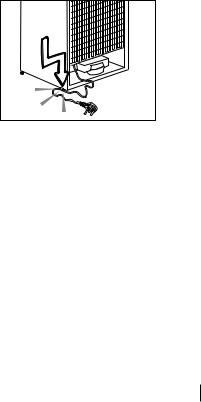
•This operation manual should be handed in to the new owner of the product when it is given to others.
•Avoid causing damage on power cable when transporting the refrigerator. Bending cable may cause fire. Never place heavy objects on power cable.
•Do not touch the plug with wet hands when plugging the product.
•Do not plug the refrigerator if the wall outlet is loose.
•Water should not be sprayed on inner or outer parts of the product for safety purposes.
•Do not spray substances containing inflammable gases such as propane gas near the refrigerator
to avoid fire and |
|
explosion risk. |
7 |
•Never place containers filled with water on top of the refrigerator; in the event of spillages, this may cause electric shock or fire.
•Do not overload the refrigerator with food. If overloaded, the food
items may fall down and hurt you and damage refrigerator when you open the door.
•Never place objects on top of the refrigerator; otherwise, these objects may fall down when you open or close the refrigerator's door.
•As they require a precise temperature, vaccines, heat-sensitive medicine and scientific materials and etc. should not be kept in the refrigerator.
•If not to be used for a long time, refrigerator should be unplugged. A possible problem in power cable may cause fire.
•The plug's tip should be cleaned regularly with a dry cloth; otherwise, it may cause fire.
EN

•Refrigerator may move if adjustable legs are not properly secured on the floor. Properly securing adjustable legs on the floor can prevent the refrigerator to move.
•When carrying the refrigerator, do not hold it from door handle. Otherwise, it may be snapped.
•When you have to place your product next to another refrigerator or freezer, the distance between devices should be at least 8cm. Otherwise, adjacent side walls may be humidified.
For products with a water dispenser;
•In order to operate the water circuit of the refrigerator
smoothly, the water mains pressure must be between 1-8 bars. For conditions where water mains pressure exceeds 5 bars a pressure regulator should be used. If the water mains pressure exceeds 8 bars then
the refrigerator’s water circuit should not be connected to the water mains. If you lack the knowledge of how to measure the water mains pressure, please seek a professional support.Use drinking water only.
• Use only potable water.
Child safety
•If the door has a lock, the key should be kept away from reach of children.
•Children must be supervised to prevent them from tampering with the product.
Compliance with WEEE Directive and Disposing of the Waste Product:
This product complies
with EU WEEE Directive (2012/19/EU). This product
bears a classification symbol for waste electrical and electronic equipment
(WEEE).
This product has been manufactured with high quality parts and materials which can be reused and are suitable for recycling. Therefore, do not dispose the product with normal domestic waste at the end of its service life. Take it to a collection point for the recycling of electrical and electronic equipment. Please consult your local authorities
to learn the nearest collection point. Help protect the environment and natural resources by recycling used
8 EN

products. For children's safety, cut the power cable and break the locking mechanism of the door, if any, so
that it will be non-functional before disposing of the product.
Package information
Packaging materials of the product are manufactured from recyclable materials in accordance with our National Environment Regulations. Do not dispose of the packaging materials together with the domestic or other wastes. Take them to the packaging material collection points designated by the local authorities.
Do not forget...
Any recycled substance is an indispensable matter for nature and our national asset wealth.
If you want to contribute to the re-evaluation of the packaging materials, you can consult to your environmentalist organizations or the municipalities where you are located.
HC warning
If your product's cooling system contains R600a:
This gas is flammable. Therefore, pay attention to not damaging the cooling system and piping during usage and transportation. In the event of damage, keep your product away from potential fire sources that can cause the product catch a fire and ventilate the room in which the unit is placed.
Ignore this warning if your product's cooling system contains R134a.
Type of gas used in the product is stated in the type label which is on the left wall inside the refrigerator.
Never throw the product in fire for disposal.
Things to be done for energy saving
•Do not leave the doors of your refrigerator open for a long time.
•Do not put hot food or drinks in your refrigerator.
•Do not overload your refrigerator so that the air circulation inside of it is not prevented.
•Do not install your refrigerator under direct sunlight or near heat emitting appliances such as ovens, dishwashers or radiators. Keep your refrigerator at least 30cm away from heat emitting sources and at least 5cm from electrical ovens.
•Pay attention to keep your food in closed containers.
•For products with a freezer compartment; You can store maximum amount of food items in the freezer when you remove the shelf or drawer of the freezer. Energy consumption value stated for your refrigerator has been determined
by removing freezer shelf or drawer and under maximum load. There is no harm to use a shelf or drawer
according to the shapes and size of food to be frozen.
•Thawing frozen food in fridge compartment will both provide energy saving and preserve the food quality.
9 EN
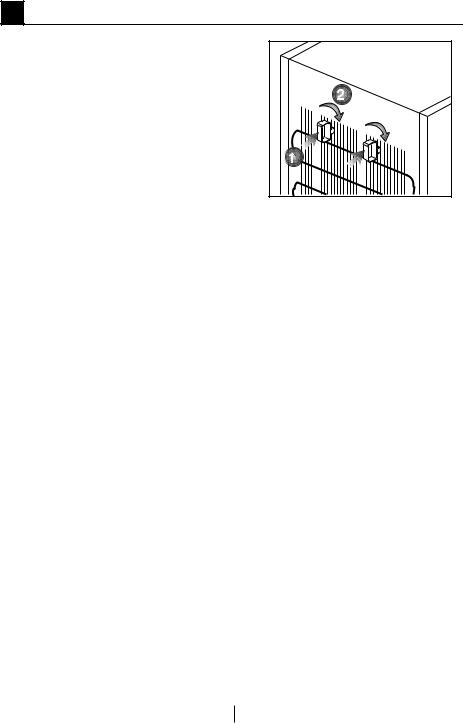
3 Installation
B In case the information which are given in the user manual are not taken into account, manufacturer will
not assume any liability for this.
Points to be paid attention to when the relocation of the refrigerator
1.Your refrigerator should be unplugged.Before transportation of your refrigerator, it should be emptied and cleaned.
2.Before it is re-packaged, shelves, accessories, crisper, etc. inside your refrigerator should be fixed with adhesive tape and secured against impacts. Package should be bound with a thick tape or sound ropes and the transportation rules on the package should be strictly observed.
3.Original packaging and foam materials should be kept for future
transportations or moving.
Before you start the refrigerator,
Check the following before you start to use your refrigerator:
1.Attach 2 plastic wedges as illustrated below. Plastic wedges are intended to keep the distance which will ensure the air circulation between your refrigerator and the wall. (The picture is drawn up as a representation and it is not identical with your product.)
2.Clean the interior of the refrigerator as recommended in the “Maintenance and cleaning” section.
3.Connect the plug of the refrigerator to the wall socket. When the fridge door is opened, fridge internal lamp will turn on.
4.When the compressor starts to operate, a sound will be heard. The liquid and gases sealed within the refrigeration system may also give rise to noise, even if the compressor is not running and this is quite normal.
5.Front edges of the refrigerator may feel warm. This is normal. These areas are designed to be warm to
avoid condensation.
Electrical connection
Connect your product to a grounded socket which is being protected by a fuse with the appropriate capacity.
Important:
The connection must be in compliance with national regulations.
•The power plug must be easily accessible after installation.
•Electrical safety of your refrigerator shall be guaranteed only if the earth system in your house complies with standards.
•The voltage stated on the label located at left inner side of your product should be equal to your network voltage.
•Extension cables and multi plugs must not be used for connection.
10 EN

B A damaged power cable must be replaced by a qualified electrician.
B Product must not be operated before it is repaired! There is the risk of
electric shock!
Disposing of the packaging
The packing materials may be dangerous for children. Keep the packing materials out of the reach of children or dispose of them by
classifying them in accordance with the waste instructions stated by your local authorities. Do not throw away with regular house waste, throw away on packaging pick up spots designated by the local authorities.
The packing of your refrigerator is produced from recyclable materials.
Disposing of your old refrigerator
Dispose of your old refrigerator without giving any harm to the environment.
•You may consult your authorized dealer or waste collection center of your municipality about the disposal of your refrigerator.
Before disposing of your refrigerator, cut out the electric plug and, if there are any locks on the door, make them inoperable in order to protect children against any danger.
Placing and Installation
A If the entrance door of the room where the refrigerator will be installed is not wide enough for the refrigerator to pass through, then call the authorized service to have them remove the doors of your refrigerator and pass it sideways through the door.
1.Install your refrigerator to a place that allows ease of use.
2.Keep your refrigerator away from heat sources, humid places and direct sunlight.
3.There must be appropriate air ventilation around your refrigerator in order to achieve an efficient operation. If the refrigerator is to be placed in a recess in the wall, there must be at least 5 cm distance with the ceiling and at least 5 cm with the wall. Do not place your product on the materials such as rug or carpet.
4.Place your refrigerator on an even floor surface to prevent jolts.
11 EN

Adjusting the legs
If your refrigerator is unbalanced;
You can balance your refrigerator by turning its front legs as illustrated in the figure. The corner where the leg exists is lowered when you turn in the direction of black arrow and raised when you turn in the opposite
direction. Taking help from someone to slightly lift the refrigerator will facilitate this process.
Installing the lower ventilation cover
You can install the lower ventilation cover as illustrated in the figure.
Replacing the interior lamp
Should the light fail to work, proceed as follows.
1.Switch off at the socket outlet and pull out the mains plug.You may find it useful to remove shelves for easy access.
2.Use a flat tipped screwdriver to remove the light diffuser cover.
3.First check that the lamp hasn’t worked loose by ensuring it is screwed securely in the holder. Replace the plug and switch on.
4.If the lamp works, replace the light cover by inserting the rear lug and pushing up to locate the front two lugs.
5.If the light still fails to work, switch off at the socket outlet and pull out the mains plug. Replace the lamp with a new 15 watt (max) screw cap (SES) lamp.
6.Carefully dispose of the burnt-out lamp immediately.
7.Replacement light lamp can easily be obtained from a good local electrical or DIY store.
12 EN

Turbo Cooling Fan
“Turbo cooling fan is designed to ensure homogenous distribution and circulation of the cold air inside your refrigerator. Operation time of the turbo cooling fan may vary depending on the properties of your product. While the turbo fan works only with the compressor in some products, the control system determines its operation time in some products
in accordance with the cooling requirement. This situation is explained on a separate warning and information label attached on the refrigerator in products equipped with turbo fans running under different conditions than the compressor.”
Icematic and ice storage container
*optional
Using the Icematic
Fill the Icematic with water and place it into its seat. Your ice will be ready approximately in two hours. Do not remove the Icematic from its seating to take ice.
Turn the knobs on the ice reservoirs clockwise by 90 degrees.
Ice cubes in the reservoirs will fall down into the ice storage container below.
You may take out the ice storage container and serve the ice cubes.
If you wish, you may keep the ice cubes in the ice storage container.
Ice storage container
Ice storage container is only intended for accumulating the ice cubes. Do not put water in it. Otherwise, it will break.
13 |
EN |
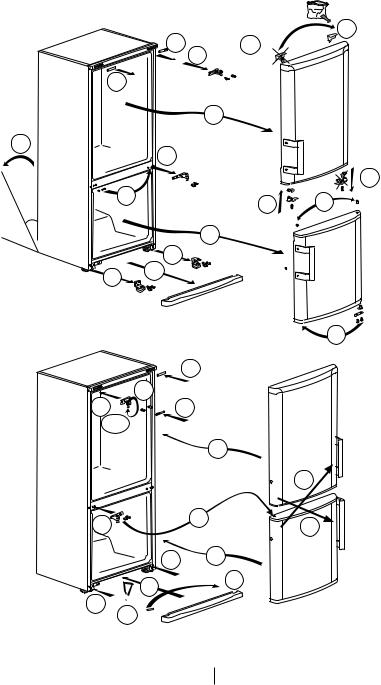
Reversing the doors
Proceed in numerical order
4
8
45°
9
21
4 |
|
11 |
5 |
11 |
|
|
|
2
1
12
6 |
13 |
14 |
|
3
10 7
15
22
20
22
180°
|
|
25 |
|
|
27 |
26 |
24 |
27 |
|
17 23
19 






 18
18
19






16
14 EN
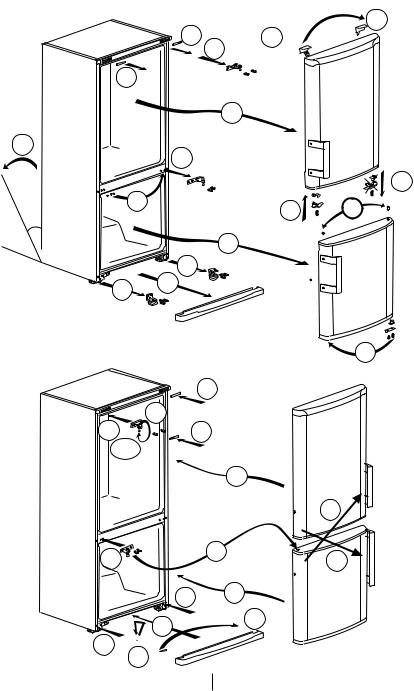
Reversing the doors
Proceed in numerical order
4 |
|
11 |
5 |
11 |
|
|
|
4
|
|
2 |
|
|
8 |
|
1 |
|
|
|
|
|
||
|
6 |
|
12 |
|
45° |
13 |
14 |
||
|
||||
|
|
|
3
10
9 7
15
|
22 |
|
21 |
20 |
|
22 |
|
|
180° |
|
|
|
|
25 |
|
|
27 |
26 |
24 |
27 |
|
17 23
19 






 18
18
19






16
15 EN

4 Preparation
•Your refrigerator should be installed at least 30 cm away from heat sources such as hobs, ovens, central heater and stoves and at least 5 cm away from electrical ovens and should not be located under direct sunlight.
•The ambient temperature of the room where you install your refrigerator should at least be 10°C. Operating your refrigerator under cooler conditions is not recommended with regard to its efficiency.
•Please make sure that the interior of your refrigerator is cleaned thoroughly.
•If two refrigerators are to be installed side by side, there should be at least 2 cm distance between them.
•When you operate your refrigerator for the first time, please observe the following instructions during the initial six hours.
•The door should not be opened frequently.
•It must be operated empty without any food in it.
•Do not unplug your refrigerator. If a power failure occurs out of your control, please see the warnings in
the “Recommended solutions for the problems” section.
•Original packaging and foam materials should be kept for future transportations or moving.
16 EN
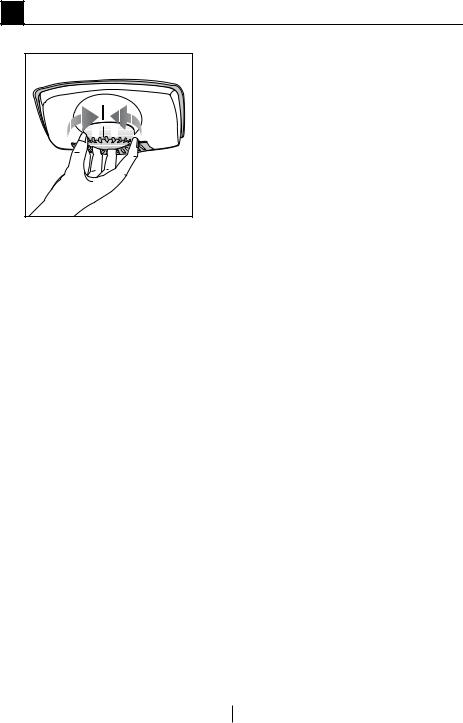
5 Using your refrigerator
Thermostat setting button
The interior temperature of your refrigerator changes for the following reasons;
•Seasonal temperatures,
•Frequent opening of the door and leaving the door open for long periods,
•Food put into the refrigerator without cooling down to the room temperature,
•The location of the refrigerator in the room (e.g. exposing to sunlight).
•You may adjust the varying interior temperature due to such reasons by using the thermostat. Numbers around the thermostat button indicates the cooling degrees.
•If the ambient temperature is higher than 32°C, turn the thermostat button to maximum position.
•If the ambient temperature is lower than 25°C, turn the thermostat button to minimum position.
Defrost
Fridge compartment
Fridge compartment performs fullautomatic defrosting. Water drops and a frosting up to 7-8 mm can occur
on the inner rear wall of the fridge compartment while your refrigerator cools down. Such formation is normal as a result of the cooling system.
The frost formation is defrosted by performing automatic defrosting with certain intervals thanks to the
automatic defrosting system of the rear wall. User is not required to scrape the frost or remove the water drops.
Water resulting from the defrosting passes from the water collection groove and flows into the evaporator through the drain pipe and evaporates here by itself.
Deep freezer compartment does not perform automatic defrosting in order to prevent decaying of the frozen food.
The freezer compartment defrosts automatically.
17 EN

Water Dispenser
*optional
The water dispenser is a very useful feature allowing cold water on tap without opening the door of your refrigerator .As you will not have to open your refrigerator door frequently, you will have saved energy.
Using the water dispenser
Push the arm of the water dispenser with your glass. The dispenser will cease operating once you release the arm.
When operating the water dispenser, maximum flow can be obtained
by pressing the arm fully. Please remember that the amount of flow from the dispenser is subject to the degree you press the arm.
As the level of the water in your glass/ container rises, slightly lessen the pressure on the arm to prevent the overspill. If you slightly press the arm, the water will drip; this is quite normal and not a failure.
Filling the water dispenser's tank
Open the cover of the water tank as shown in the figure. Fill in the pure and clean drinking water. Close the cover.
To avoid flowing of water by mistake, we recommend you to lock the water dispenser .
Warning!
•Do not fill the water tank with any other liquid except for water such as fruit juices, carbonated beverages or alcoholic drinks which are not
suitable to use in the water dispenser. Water dispenser will be irreparably damaged if these kinds of liquids are used. Warranty does not cover such usages. Some chemical substances and additives contained in these kinds of drinks/liquids may damage the water tank.
•Use clean and pure drinking water only.
•Capacity of the water tank is 2.2 Litres (3.8 pints); do not overfill.
•Push the arm of the water dispenser
18 EN

with a rigid glass. If you are using disposable plastic glasses, push the arm with your fingers from behind the glass.
1  2
2
 1
1
Cleaning the water tank
Release the tank cover from the water tank by opening latches at both sides. Remove the water tank and clean with warm and clean water. Place the water tank to its seating, install the tank cover and close the latches.
3 |
Make sure that the parts removed (if any) during cleaning are properly attached to their original places.
Otherwise, water leakage may occur.
Important:
Components of the water tank and water dispenser should not be washed in dishwasher.
Water tray
Water that dripped while using the water dispenser accumulates in the spillage tray. Take out the spillage tray by pulling it towards yourself and empty it regularly.
Take out the plastic strainer by pressing it on sides.
Take the water valve out of the water tank. When replacing it, make sure that the seal is in place.
19 EN

6 Maintenance and cleaning
A Never use gasoline, benzene or similar substances for cleaning purposes.
B We recommend that you unplug the appliance before cleaning.
B Never use any sharp abrasive instrument, soap, household cleaner, detergent and wax polish for cleaning.
CUse lukewarm water to clean the cabinet of your refrigerator and wipe it dry.
CUse a damp cloth wrung out in a solution of one teaspoon of
bicarbonate of soda to one pint of water to clean the interior and wipe it dry.
B Make sure that no water enters the lamp housing and other electrical items.
B If your refrigerator is not going to be used for a long period of time, unplug the power cable, remove all food, clean it and leave the door ajar.
CCheck door seals regularly to ensure they are clean and free from food particles.
A To remove door racks, remove all the contents and then simply push the door rack upwards from the base.
ANever use cleaning agents or water that contain chlorine to clean the outer surfaces and chromium coated parts of the product. Chlorine causes
corrosion on such metal surfaces.
Protection of plastic surfaces
CDo not put the liquid oils or oil-cooked meals in your refrigerator in unsealed containers as they damage the plastic surfaces of your refrigerator. In case of spilling or smearing oil on the plastic surfaces, clean and rinse the relevant part of the surface at once with warm water.
20 EN

7 Troubleshooting
Please review this list before calling the service. It will save your time and money. This list includes frequent complaints that are not arising from defective workmanship or material usage. Some of the features described here may not exist in your product.
The refrigerator does not operate.
•The plug is not inserted into the socket correctly. >>>Insert the plug into the socket securely.
•The fuse of the socket which your refrigerator is connected to or the main fuse have blown out. >>>Check the fuse.
Condensation on the side wall of the fridge compartment (MULTIZONE, COOL CONTROL and FLEXI ZONE).
•Ambient is very cold. >>>Do not install the refrigerator in places where the temperature falls below 10 °C.
•Door has been opened frequently. >>>Do not open and close the door of refrigerator frequently.
•Ambient is very humid. >>>Do not install your refrigerator into highly humid places.
•Food containing liquid is stored in open containers. >>>Do not store food with liquid content in open containers.
•Door of the refrigerator is left ajar. >>>Close the door of the refrigerator.
•Thermostat is set to a very cold level. >>>Set the thermostat to a suitable level.
•Compressor is not running
•Protective thermic of the compressor will blow out during sudden power failures or plug-out plug-ins as the refrigerant pressure in the cooling system of the refrigerator has not been balanced yet. The refrigerator will start running
approximately after 6 minutes. Please call the service if the refrigerator does not startup at the end of this period.
•The fridge is in defrost cycle. >>>This is normal for a full-automatically defrosting refrigerator. Defrosting cycle occurs periodically.
•The refrigerator is not plugged into the socket. >>>Make sure that the plug is fit into the socket.
•Temperature settings are not made correctly. >>>Select the suitable temperature value.
•There is a power outage. >>>Refrigerator returns to normal operation when the power restores.
21 EN

The operation noise increases when the refrigerator is running.
•The operating performance of the refrigerator may change due to the changes in the ambient temperature. It is normal and not a fault.
The refrigerator is running frequently or for a long time.
•New product may be wider than the previous one. Larger refrigerators operate for a longer period of time.
•The room temperature may be high. >>>It is normal that the product operates for longer periods in hot ambient.
•The refrigerator might be plugged in recently or might be loaded with food.
>>>When the refrigerator is plugged in or loaded with food recently, it will take longer for it to attain the set temperature. This is normal.
•Large amounts of hot food might be put in the refrigerator recently. >>>Do not put hot food into the refrigerator.
•Doors might be opened frequently or left ajar for a long time. >>>The warm air that has entered into the refrigerator causes the refrigerator to run for longer periods. Do not open the doors frequently.
•Freezer or fridge compartment door might be left ajar. >>>Check if the doors are closed completely.
•The refrigerator is adjusted to a very low temperature. >>>Adjust the refrigerator temperature to a warmer degree and wait until the temperature is achieved.
•Door seal of the fridge or freezer may be soiled, worn out, broken or not properly seated. >>>Clean or replace the seal. Damaged/broken seal causes the refrigerator to run for a longer period of time in order to maintain the current temperature.
Freezer temperature is very low while the fridge temperature is sufficient.
•The freezer temperature is adjusted to a very low value. >>>Adjust the freezer temperature to a warmer degree and check.
Fridge temperature is very low while the freezer temperature is sufficient.
•The fridge temperature is adjusted to a very low value. >>>Adjust the fridge temperature to a warmer degree and check.
Food kept in the fridge compartment drawers is frozen.
•The fridge temperature is adjusted to a very high value. >>>Adjust the fridge temperature to a lower value and check.
22 EN

Temperature in the fridge or freezer is very high.
•The fridge temperature is adjusted to a very high value. >>>Fridge compartment temperature setting has an effect on the temperature of the freezer. Change the temperatures of the fridge or freezer and wait until the relevant compartments attain a sufficient temperature.
•Doors are opened frequently or left ajar for a long time. >>>Do not open the doors frequently.
•Door is ajar. >>>Close the door completely.
•The refrigerator is plugged in or loaded with food recently. >>>This is normal. When the refrigerator is plugged in or loaded with food recently, it will take longer for it to attain the set temperature.
•Large amounts of hot food might be put in the refrigerator recently. >>>Do not put hot food into the refrigerator.
•Vibrations or noise.
•The floor is not level or stable. >>> If the refrigerator rocks when moved slowly, balance it by adjusting its feet. Also make sure that the floor is strong enough to carry the refrigerator, and level.
•The items put onto the refrigerator may cause noise. >>>Remove the items on top of the refrigerator.
There are noises coming from the refrigerator like liquid flowing, spraying, etc.
•Liquid and gas flows occur in accordance with the operating principles of your refrigerator. It is normal and not a fault.
Whistle comes from the refrigerator.
•Fans are used in order to cool the refrigerator. It is normal and not a fault. Condensation on the inner walls of refrigerator.
•Hot and humid weather increases icing and condensation. It is normal and not a fault.
•Doors are opened frequently or left ajar for a long time. >>>Do not open the doors frequently. Close them if they are open.
•Door is ajar. >>>Close the door completely.
Humidity occurs on the outside of the refrigerator or between the doors.
•There might be humidity in the air; this is quite normal in humid weather. When the humidity is less, condensation will disappear.
23 EN

Bad odour inside the refrigerator.
•No regular cleaning is performed. >>>Clean the inside of the refrigerator regularly with a sponge, lukewarm water or carbonate dissolved in water.
•Some containers or package materials may cause the smell. >>>Use a different container or different brand packaging material.
•Food is put into the refrigerator in uncovered containers. >>>Keep the food in closed containers. Microorganisms spreading out from uncovered containers can cause unpleasant odours.
•Remove the foods that have expired best before dates and spoiled from the refrigerator.
The door is not closing.
•Food packages are preventing the door from closing. >>>Replace the packages that are obstructing the door.
•The refrigerator is not completely even on the floor. >>>Adjust the feet to balance the refrigerator.
•The floor is not level or strong. >>>Make sure that the floor is level and capable to carry the refrigerator.
Crispers are stuck.
• The food is touching the ceiling of the drawer. >>>Rearrange food in the drawer.
24 EN
Por favor, leia primeiro este manual!
Caro cliente,
Esperamos que o seu produto, que foi produzido em modernas instalações e testado através de rigorosos controlos de qualidade, ofereça-lhe um serviço efectivo.
Para isso, recomendamos que leia cuidadosa e inteiramente o manual do seu produto antes de utilizá-lo e guarde-o para futuras consultas.
Este manual
•Ajudá-lo-á a utilizar o seu equipamento de forma rápida e segura.
•Leia o manual antes de instalar e operar o seu equipamento.
•Siga as instruções, especialmente as relativas à segurança.
•Guarde o manual num local acessível, já que poderá precisar dele mais tarde.
•Além disso, leia também os outros documentos fornecidos com o seu produto. Observe que este manual também pode ser válido para outros modelos.
Os símbolos e as suas descrições
Este manual de instruções contém os seguintes símbolos:
C
A Aviso sobre as condições de risco para a vida e a propriedade.
B Aviso sobre a voltagem eléctrica.

CONTEÚDO
1 O seu frigorífico |
3 |
2 Avisos importantes de |
|
segurança |
4 |
Uso pretendido.................................. |
4 |
Para produtos com um dispensador de |
|
água;................................................. |
8 |
Segurança com crianças.................... |
9 |
Conformidade com a Directiva WEEE e |
|
Eliminação de Resíduos: ................... |
9 |
Cumprimento com a Directiva RoHS:.9 |
|
Informação sobre a embalagem......... |
9 |
Aviso HC............................................ |
9 |
O que se pode fazer para economizar |
|
energia............................................. |
10 |
4 Preparação |
17 |
5 Utilizar o seu frigorífico |
18 |
Dispensador de água....................... |
19 |
*opcional.......................................... |
19 |
6 Manutenção e limpeza |
22 |
Protecção das superfícies plásticas .22 |
|
7 Soluções recomendadas para |
|
os problemas |
23 |
3 Instalação |
11 |
Pontos a serem considerados |
|
ao transportar novamente o seu |
|
frigorífico.......................................... |
11 |
Antes de funcionar o seu frigorífico... |
11 |
Eliminação da embalagem............... |
12 |
Eliminação do seu frigorífico velho.... |
12 |
Colocação e instalação.................... |
12 |
Ajuste dos pés................................. |
13 |
Instalação da tampa da ventilação |
|
inferior.............................................. |
13 |
Substituição da lâmpada interior ..... |
13 |
Icematic e reservatório de |
|
armazenamento de gelo................... |
14 |
2 PT

1 O seu frigorífico
|
1 |
12 |
|
13 |
|
|
2 |
|
|
3 |
|
|
4 |
|
|
14 |
|
16 |
|
15 |
|
|
|
|
5 |
|
|
6 |
14 |
|
|
|
|
7 |
|
|
8 |
|
17 |
9 |
|
|
|
|
|
10 |
|
|
11 |
|
1. |
Luz interior |
10.Grade do ar |
2. |
Botão do termostato |
11.Pés frontais ajustáveis |
3. |
Fan |
12.Prateleiras da porta ajustável |
4. |
Prateleiras ajustáveis corpo |
13.Titulares de ovo |
5. |
Cobertura crisper |
14.Prateleira para garrafas |
6. |
Salada nítidas |
15.Dispensador de água |
7. |
Banco de gelo |
16.Compartimento frigorífico |
8. |
Bandeja de banco de gelo |
17.Congelador |
9. |
Congelador |
|
CAs figuras que aparecem neste manual de instruções são esquemáticas e podem não corresponder exactamente ao seu produto. Se as partes referidas não estiverem incluídas no produto que adquiriu, é porque são válidas para outros modelos.
3 PT

2 Avisos importantes de segurança
Por favor, reveja as informações seguintes. A não-observância destas informações pode causar
ferimentos ou |
danos |
ao |
||
material. |
Caso |
contrário, |
||
todas |
as |
garantias |
||
e |
compromissos |
de |
||
fiabilidade |
tornar-se-ão |
|||
inválidos. |
|
|
|
|
A vida útil da unidade que adquiriu é de 10 anos. Este é o período para manter
as |
peças de |
reposição |
exigidas para |
a unidade |
|
a |
funcionarem |
conforme |
descrito. |
|
|
Uso pretendido
Este produto está concebido para ser usado
•áreas internas e fechadas como casas;
•em ambientes de trabalho fechados, como lojas e escritórios;
•em áreas de hospedagem fechadas, como casas rurais, hotéis, pensões.
•Este produto não deve ser usado em exteriores.
Segurança geral
•Quando quiser eliminar/ desfazer-se do produto, recomendamos que consulte o serviço de assistência e os órgãos autorizados para obter mais informações.
•Consulte o seu serviço de assistência autorizado para todas as questões e problemas relativos
ao frigorífico. Não tente reparar e nem permita que ninguém o faça sem notificar os serviços de assistência autorizados.
•Para produtos com um compartimento de congelador; Não coma cones de gelados e cubos de gelo imediatamente após retirá-los do compartimento do congelador! (Isto pode
provocar queimaduras de frio na sua boca).
•Para produtos com compartimento de congelador; Não coloque bebidas
4 PT

líquidas enlatadas ou engarrafadas no compartimento do congelador. Caso contrário, podem rebentar.
•Não toque nos alimentos congelados; podem ficar presos à sua mão.
•Desligue o seu frigorífico da tomada antes da limpeza ou descongelação.
•O vapor e materiais de limpeza vaporizados nunca deverão
ser utilizados nos processos de limpeza e descongelação do seu frigorífico. Em tais casos, o vapor poderá entrar em contacto com as partes eléctricas e provocar curto-circuito ou choque eléctrico.
•Nunca use as partes do seu frigorífico, tal como a porta, como meios de apoio ou degrau.
•Não utilize dispositivos eléctricos dentro do frigorífico.
•Não danifique as partes por onde circula a refrigeração, com
ferramentas perfurantes ou cortantes. O refrigerante que pode explodir quando os canais de gás do evaporador, as extensões do tubo
ou os revestimentos da superfície são perfurados, causa irritações na pele ou ferimentos nos olhos.
•Não cubra ou bloqueie os orifícios de ventilação do seu frigorífico com nenhum tipo de material.
•Os dispositivos eléctricos só devem ser reparados por pessoas autorizadas. As reparações realizadas por pessoas incompetentes causam riscos ao utilizador.
•Em caso de qualquer falha quer durante uma manutenção ou num trabalho de reparação, desligue a alimentação eléctrica do seu frigorífico, desligando o fusível correspondente ou retirando a ficha da tomada.
•Não puxe pelo cabo quando for retirar a ficha da tomada.
5 PT
